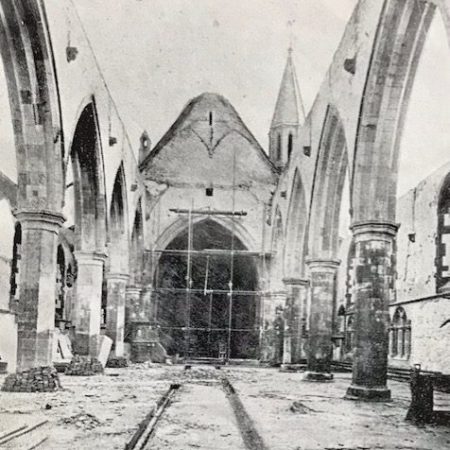Royal Garrison Church stands by the sea on the edge of Old Portsmouth. Its picturesque silhouette, beautiful stained-glass windows, and Victorian and Edwardian interior are full of history.
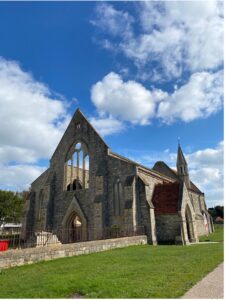
Image One: Royal Garrison Church today.
Image description: An image of the exterior of Royal Garrison Church under a blue sky. There is no roof over much of the building, and no glass in the windows.
The church started out as a ‘Domus Dei’, or ‘God’s House’ in 1212. It was used as a hospital until 1540, when Henry VIII closed religious houses. The church became the property of the crown, and in the late sixteenth-century was converted into an armoury and a residence for Portsmouth’s military governor. The governor’s house played host to royal visitors, including Charles II, who married his Portuguese bride, Catherine of Braganza, there in 1661. This building was demolished in 1826; however, the church itself was restored in 1866 by architect George Edmund Street and was a centre of worship for British troops serving in Portsmouth.
During the Second World War, a devastating event almost destroyed the church and its artefacts altogether. During the third Blitz bombings on Portsmouth, on 27 April 1941, a German incendiary bomb was dropped on the Royal Garrison Church. Though small, the bomb wrought a huge amount of damage: most significantly, the roof was destroyed, and the stained-glass windows blown out. Image Two shows the church as it was in 1944, with debris covering the site and scaffolding needed to support the archway.
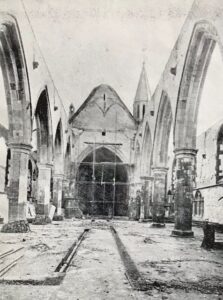
Image Two: The damaged church in 1944.
Image description: A photo taken from the interior of Royal Garrison Church. The roof has been blown off, and there is debris on the ground. There is scaffolding supporting the archway.
To commemorate this event, on 27 April 2025, English Heritage held a collaborative event with the Pompey Pals. Pompey Pals is a charity which remembers the men and women from the Portsmouth area who served in the military over the last 150 years. Volunteers from Pompey Pals brought an array of fascinating exhibition items to the church. The opportunity to view these items within the church was an engaging experience for both visitors and Royal Garrison Church volunteers.
For instance, Image Three shows a German incendiary bomb, with Image Four detailing its internal makeup. The bomb was just over 14-inches in length and weighed the same as a bag of sugar. Thousands of these bombs were dropped on Portsmouth, including on Royal Garrison Church and the Guildhall, causing widespread damage and outbreaks of fire.

Image Three: German incendiary bomb.
Image description: A silver magnesium bomb with a green iron tail lying upon a wooden table. A tape measure shows the bomb reaches over 14-inches in length.
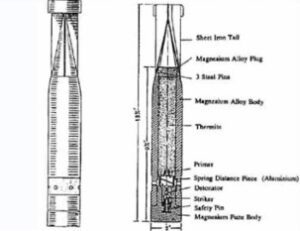
Image Four: The internal makeup of the German incendiary bomb.
Image description: A diagram showing two outlines of the bomb, one of the exterior and one of the interior. The interior elements of the bomb are labelled with the materials and names.
As well as the bomb itself, there were posters and newspapers on display from the 1940s. Image Five depicts a poster from the Second World War raising awareness of the threat from these explosives. Additionally, Image Six shows a publication by The News in 1945, entitled “Smitten City”. This provided visitors with a photographic record of the bombing of Portsmouth during the Second World War.

Image Five: A poster depicting an incendiary bomb.
Image description: A blue poster featuring an flaming incendiary bomb with an angry face in the centre. The text reads “Beat ‘firebomb fritz’. Britain shall not burn. Britain’s fire guard is Britain’s defence”.
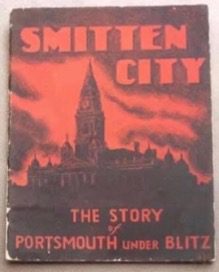
Image Six: Smitten City, 1945.
Image description: A publication with a black and red cover featuring the Guildhall. The text reads: “Smitten City. The story of Portsmouth under Blitz”.
Another fascinating document provided by Pompey Pals is Image Seven, which depicts the equipment that was needed to tackle the threat from these incendiary bombs. It was important that they were dealt with immediately as they burned at high temperatures and were very difficult to extinguish once the fire had taken hold. Fortunately, the blaze was extinguished at Royal Garrison Church, saving many of the collection items. The scorch marks from the blaze on the wooden pews can still be seen today.

Image Seven: “Dron-wal” for Safety and Protection.
Image description: A sheet depicting some of the equipment needed to tackle incendiary bombs. There are images of a dual jet and spray nozzle, wall hangers for the pumps, and a decontamination attachment.
The exhibition event was popular with both local residents and visitors from afar. The Royal Garrison Church team were also excited to have a visit from the then Lord Mayor of Portsmouth, Jason Fazackarley. Image Eight shows the Lord Mayor with two volunteers from the Royal Garrison Church team: Caro Thomas and an anonymous volunteer, and Free Sites Coordinator at English Heritage: Maureen Coyle.
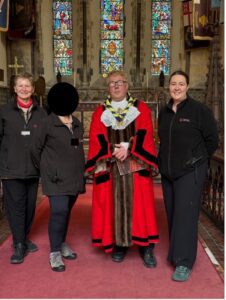
Image Eight: From left to right: Caro Thomas, an anonymous volunteer, Lord Mayor Jacob Fazackarley, and Maureen Coyle in the interior of Royal Garrison Church.
Image description: Four people standing in the interior of Royal Garrison Church, facing the camera. Three are wearing English Heritage uniform, and the Lord Mayor wears red robes.
Many thanks go to the Royal Garrison Church volunteer team and Pompey Pals for facilitating this collaboration, with a special mention to Chris from Pompey Pals for providing six of the images featured in this post and their informative explanations. We hope you will join us for future events – keep up to date with these here on the English Heritage website.

Author: Immy Tozer
Bio: Immy Tozer is a PhD History student specialising in early modern literature. Her research examines Anglo-Christian representations of Jews between 1590 and 1664. She is also an Outreach Fellow for the Parkes Institute of Jewish/Non-Jewish Relations, and is currently leading a digital project entitled Historic Jewish Hampshire. She has volunteered with English Heritage since 2022, first at Wolvesey Castle in Winchester, and currently at Royal Garrison Church in Portsmouth.

